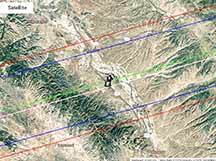
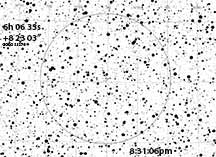
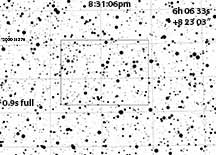
This event is worth a go as it's in the path for deploying for the main event tonight: Centaur asteroid 2013 LU28 which is 1hr 29 minutes after this event. If we hurry, we should be able to pack and re-deploy Sandy, Kirk, and myself in time, but leaving Bernard as is. This event is bright enough and long enough to enable good data to be gathered. This event is also a danger, though, for a "moonlet hunt" for Argentina. Bernard may have the ability to practice before hand and have confidence of being able to do an Argentina moon hunt, and then quickly get on target 9 minutes later for this 2000 SJ276 event. Any question on that I'd favor getting this 2000 SJ276 event as the moonlet hunt is highly unlikely to find anything.
It would be good to put Bernard and his two telescopes permanently inside this path as a reasonable choice. Any moonlet seein in one record could be confirmed in the 2nd telescope record. (how to get recordings of both??). It would give him extra time to get the two telescopes set up, and if the 2013 LU23 event is shorter, his 10" scope will have better odds of getting it above noise level than will our 8" scopes.
As usual, these charts assume the observer is using the 2" diagonal and Q70 32mm eyepiece for the round circle chart, and is using the Watec 910hx with f/3.3 reducer in 'straight through' orientation and with the RCA video gold BNC connector on the Watec in the 'up' orientation as you look at it from the back.
Alt=58, Az=208 high in the SSW in Orion. Duration=0.9s full drop. Sun alt= -15, it's dark now.
 |
 |
 |
|
Sandy is northernmost site. Behind a grove of trees for any presumed northwind protection. |
This may be the better more preferred site for Kirk. It's got more wind protection, headlight protection, and less likely perhaps to be disturbed by traffic. KB2 |
KB1;I no longer favor this site for Kirk, but it's a backup so I leave it on our planning page. KB2 is preferred. |
Bernard is behind a grove of big trees at the junction with the winery dirt road to "Krushwerks" Since this is also his site for the Centaur occultation, I've made sure he has wind protection. |
I'm farthest south, at a bend in the road. No tree protection but I have the van to help if needed. |
I set our team at the sites as above; with Kirk at site KB2. The clear skies forecast did not quite happen. We had periods of clear, clear patches, interspersed with cloud and with rain. It was a post-storm front period of high convective instability and scattered clear/showers. From North to South...
Rain came in not long after he'd set up. Luckily, there was an outdoor picnic table with covering over the top so he could move all gear out of the rain. No data.
It was clear over the Argentina target, but the quick go-to to 2000 SJ276 showed it behind a cloud. Rain came soon after that. No data.
Similar to Kirk, Bernard got the Argentina target, but was not able to get to 2000 SJ276. No data.
I got on Argentina, had trouble getting the camcorder started since I had two, and the one Sandy gave me back, had weak batteries and a cryptic red flashing icon on the camcorder screen; it took a few moments to figure out what happened and scramble to find my own camcorder remote. I got on 2000 SJ276 efficiently even though the original GoTo was not on target. But when I did finally ID the field, I wrote down the RA and Dec the 8SE thought it was at, and then input those after Argentina and it went nicely to the target. Up to and during the occultation the cloud cover over the 13.0 target was thin and thinning, with a short period of a cloud, then clear'ish until the occultation. 10s later, thicker clouds came in and it was too noisy to keep within the data. I had to trim it out before PyOTE. The stars were not very well focused; I could detect a disk-like uneven shape to the stars, and so I used the dynamic mask in PyMovie. I used 8x setting.
PyOTE was able to find a solid event, NIE distributions were 6.5 sigma apart, and the event was just 1/2s late. The composite light curves show I was lucky to have the event happen during an extended clear period mostly before the event. Enough to get a good enough signal for the target.
magDrop report: percentDrop: 92.9 magDrop: 2.869 +/- 1.694 (0.95 ci)
DNR: 2.14
D time: [03:31:06.3652]
D: 0.6800 containment intervals: {+/- 0.0505} seconds
D: 0.9500 containment intervals: {+/- 0.1522} seconds
D: 0.9973 containment intervals: {+/- 0.3964} seconds
R time: [03:31:07.1051]
R: 0.6800 containment intervals: {+/- 0.0505} seconds
R: 0.9500 containment intervals: {+/- 0.1522} seconds
R: 0.9973 containment intervals: {+/- 0.3964} seconds
Duration (R - D): 0.7399 seconds
Duration: 0.6800 containment intervals: {+/- 0.0759} seconds
Duration: 0.9500 containment intervals: {+/- 0.1909} seconds
Duration: 0.9973 containment intervals: {+/- 0.4052} seconds
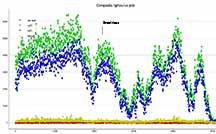 |
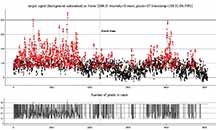 |
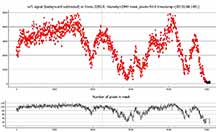 |
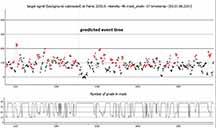 |
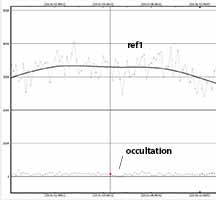 |
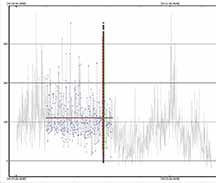 |
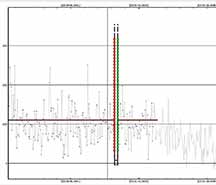 |
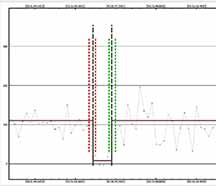 |
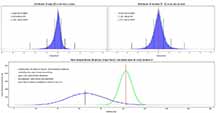 |